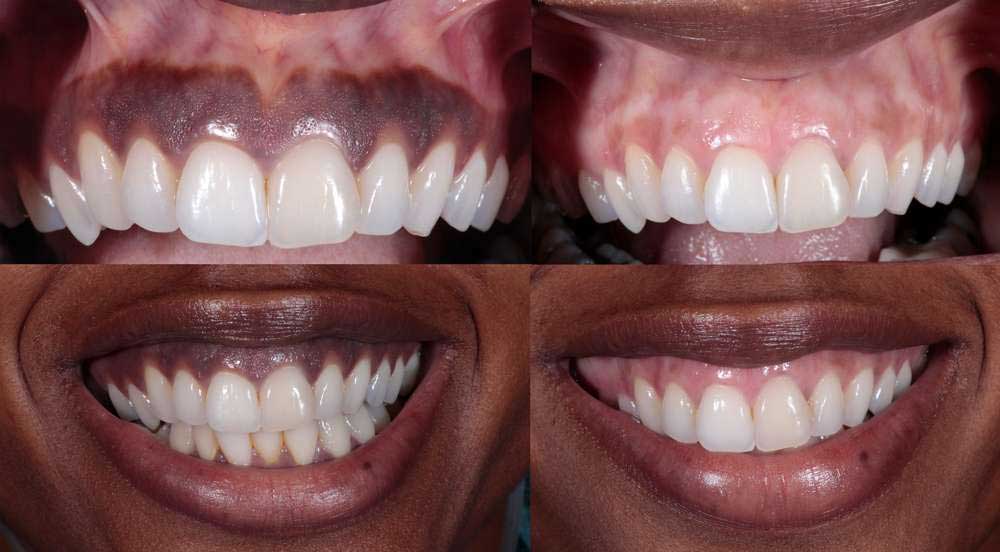Why Are My Gums Dark: 5 Discoloration Reasons
A beautiful smile is a sign of the overall health of its owner. Healthy gums are usually pale pink and firm to the touch. But what if the gums change color? Or you have black spots on your gums, black spots around your teeth, or your gums are turning dark? These could be regular hormonal changes, or they could be the sign of a more serious medical condition. Keep reading to learn more about the possible causes of black gums, darkened gums, and gum discoloration.
Common Causes for Gum Discoloration
Normally, people of the European race have pale-pink gums; people with dark skin color have a brown shade on it, due to the extra melanin production. If the color of the gums changes, it is a signal of various diseases, even if they do not show up visibly. The most typical issue is that while turning black, gums lose it’s natural look and makes the person feels uncomfortable. Below you can find the list of this and other symptoms with possible reasons for it.
- Pale gums: anemia and side effect of bleaching
- Red gums color: inflammation
- Bluish-gray and blue spots: drugs, poisoning
- White spots: stomatitis, leukoplakia, thrush
- Brown and black spots: smoking, diseases
Gums may be abnormally pale. This would not be a white color, but not a healthy pink. Anemia can be the cause of this problem; then the pallor will be associated with a decreased content of hemoglobin in the blood.
Sometimes the gums become pale as a result of teeth whitening. This gum lightening side effect is a result of the whitening agent usage. It will disappear in a short period of time.
The bright red color of the gums indicates an active inflammatory process. For example, it could be gingivitis. Bleeding is one more symptom which accompanies red gums. Local inflammation and bright red color occur while a problematic teething.
Blue spots on the gums are the result of circulatory disorders. Some drugs can also change the color of the gums. The same will happen when a person is poisoned with salts of some metals.
White patches on the gums may be symptoms of several pathologies. One of the most common diseases, when you can see white spots, is stomatitis.
Oval or round sores have red edges and white or yellowish centers. When the disease progresses, the spots become brown and black. After recovery, they disappear.
What else causes black gums?
There are several things from your overall health to gum disease, medications, and personal choices that can cause black gums and color changes to occur in gum tissue, including:
- Melanin: The body naturally creates melanin, a substance in skin, hair, and eyes. The more melanin people have in their bodies, the darker their skin and hair will be. Dark brown or black gums may be due to a person having more melanin in the body. If a person’s gums have always been dark, there is no cause for concern. If the gum color changes over time or if patches of black appear on the gums, it could be that something else is going on and not just because of melanin and should be checked by a periodontist or dentist.
- Smoking and Smoker’s Melanosis: Smoking can cause a change in the color of your gums called smoker’s melanosis. The nicotine can make melanocytes produce more melanin than usual, which will change the color of your gums. They may become more brown or black, and this change can appear in patches or affect the entire inside of your mouth. Your inner cheeks and lower lip may also turn darker. Some melanosis research suggests If you stop smoking, this discoloration might go away, suggesting that dark patches on the gums caused by smoking are reversible.
- Addison’s disease: Addison’s disease, although rare, is an illness of the adrenal glands that make hormones. This disease makes the adrenal glands not produce enough hormones. The most common cause of this is an immune disorder where the body attacks the adrenal glands. Some people with Addison’s disease can often exhibit hyperpigmentation in the form of dark patches on their gum tissue, lips, mucous membranes, and other parts of the skin outside your mouth like your knees, elbows, and palms.
- Acute necrotizing ulcerative gingivitis: Acute necrotizing ulcerative gingivitis is a gum infection commonly known as trench mouth. The symptoms are fever, pain in the gums, and bad-smelling breath. Sometimes there is black or grey tissue on the gums because of dead tissue building up over them, and ulcers may form on the edges of teeth. Trench mouth is from bacteria in the mouth. It can happen from poor oral hygiene, stress, lack of sleep, or a diet that is not healthy. The early symptoms of trench mouth are bleeding gums, bad breath, excess saliva in the mouth, and feeling sick. Treatment for this is straightforward. A dentist will clean the mouth and may prescribe antibiotics to take care of this infection. If it comes back, rinse with medicated mouthwash and keep teeth clean to help prevent repeat infections from happening again.
- Amalgam tattoo: An amalgam tattoo develops as a dark spot in your mouth and results from particles during a dental procedure that usually appears as a blue, gray, or black spot. They are not dangerous, but it can be surprising to see one appear on your gums, inner cheeks, or other parts of your mouth. Amalgam tattoos don’t cause any symptoms, they’re not painful, and they do not pose any health risks. It is good to get these spots examined by your periodontist or dentist to make sure it is not a form of oral cancer or oral malignant melanoma.
- Medication: Some medications like Minocycline, which are used to treat acne, can also cause dark gums discoloration and hyperpigmentation in your mouth and gum tissue and change your teeth’ color. If you are taking this medication and see these side effects, we recommend speaking with your medical doctor about alternative medications.
If you recognize any of these symptoms from the causes of dark gums listed above, it’s essential to see your dentist, periodontist, or medical doctor to address your concerns and propose treatment. Now that you know more about what causes black gums let’s discuss how to get rid of gums turning dark.

How to Lighten Dark Gums at Home
If you decide to take care of your gums and make sure that they are healthy, the best solution is to consult with a doctor. Of course, you can try to use medicinal herbs to reduce darkening. There are recipes of infusions with herbs such as sage, mint, lemon balm, and oregano. These components have an anti-inflammatory effect, however, the result of these measures for dark gums treatment is doubtful. Non-traditional medicine recommends the use of thyme, calamus root, chamomile, and sage. A decoction of these herbs can help anesthetize sick gums, relieve inflammation, strengthen tissues and eliminate bad breath. You have decided to try? Сonsult with your healthcare expert first.
Professional Black Gums Treatment
Have you heard about gum bleaching or gum depigmentation? This is the name of a cosmetic periodontal procedure of removing extra pigmentation and dark spots from the gums. There are 2 whitening solutions that can be used to create your renewed smile: a microdermabrasion process and a laser technique. The first solution is a traditional way of whitening. It usually takes less than an hour to complete. An expert removes the pigmented area of tissues and reveals the healthy, pale-pink tissue beneath. You won’t feel your dark gums turning pink because your mouth will be numbed to prevent any discomfort during the procedure.
In laser depigmentation, a dental laser targets and ablates melanin-producing cells in the gums. While tissue is healing, your organism creates a naturally more light gum color. A good news is that a result of a procedure lasts for your entire lifetime! This way of how to make your gums pink will make you forget about creams, gels, and other remedies. The only things you will remember are your smile and the joy from its permanent beauty.
Do you want to learn more about how we treat dark gums? Click here to read about our advanced treatment and watch Vivians life-changing gum depigmentation before and after experience.
Do you want to learn more about how we treat gum discoloration?
Click the button below to learn more about our advanced treatment and watch Vivians life-changing gum depigmentation before and after experience video.
You May Also Like...
Understanding TMJ Jaw Pain and Seeking Specialist Help
Navigating the complexities of jaw pain requires a deep dive into the various causes and conditions that lead...
Gum Overgrowth and the Causes Behind Gums Growing Over Teeth
At The Center for Advanced Periodontal & Implant Therapy in Los Angeles, CA, we know how difficult it can be to...
Stem Cells Tissue Regeneration: An Alternative to Classic Gum Graft
Gum recession is a common dental problem that affects millions of people worldwide. This condition occurs when the...



